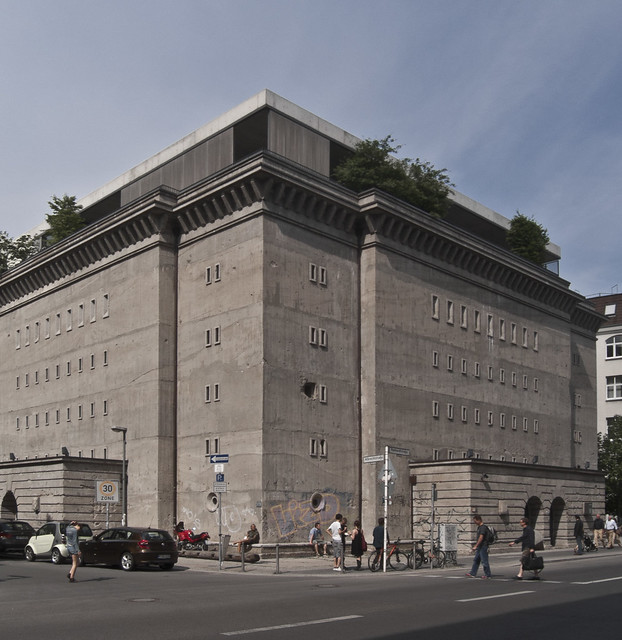 |
| Brandenburger Tor and at the Reichstag:you will get the scale of the domed-hall behind |
Just in front of the "Memorial to the Murdered Jews of Europe" it is possible to visit the exhibition ]Mythos Germania[, whose main attraction is a big model of the North-South Axis designed by Albert Speer for Berlin, the supposed-to-be capital of Hitler’s Empire, Germania: I saw before a video-rendering and some images of the master plan, and honestly (considering the function of extreme monumentality) seemed to me not that bad, after all it was a boulevard connecting the stations Südkreuz and Nordbahnohf, culminating in a big domed hall; when I had a look at the model I understood I was completely wrong.
Robert Hughes titled his good documentary about Speer “Scale matters”, and this is exactly the point: apart from the “bombarding” quantity and display of architectural elements suggesting classical architecture, domination, power, from columns to eagles of stone on the rooftops, in a mixture no less than pornographic, if one looks at the Brandenburger Tor or the Reichstag, it is easy to understand why Speer’s father told him that the project completely insane. All this reminded me a passage of Richard Sennett’s marvelous book “Flesh and Stone” about the Roman Empire and Emperors’ power:
Nero bequeathed to Hadrian a cautionary tale about rulers who nakedly display their power, yet “the emperor was what the emperor did”, in the words of the historian Ferguson Millar. Making daunting, impressive buildings was among the most important of these acts, for the emperor’s own prestige and for the Empire; through their buildings, the emperors literally constructed their legitimacy in the eyes of their subjects.
Hadrian was able to built impressively but nicely, he built the Pantheon: if Hitler was able to realize Germania I suspect that he would have followed Nero’s fate, who, after building his Domus Aurea gained just the hatred and voluntary oblivion of the Romans.
 |
| Boros bunker. Photo by World-3 |
Near Friedrichstrasse there is one of the most famous and visible bunkers of Berlin: built in 1943, used by the DDR as deposit for bananas, since the temperature and humidity were perfect for the fruit to become ripe (I can already imagine the advertisement of the “Bunker Banana”), turned in a Club known (not so originally but effective) as “The Bunker”, with even more darkrooms than the Berghain. Because it was built so late, on the facade there are many decorative elements, in case it would be kept for further use, as actually happened. In 2003 the building was bought by Christian Boros, who appointed "Realarchitektur" to renovate and transform the building, with the idea of hosting there his private collection of contemporary art. Booking some 3 months in advance it is possible with 10 euros to visit the collection and the building with a guide, in groups of 10 people: if the works of art are not masterpieces the bunker-experience is really worth. Originally there were five floors, each 2,30 m. high, so the architect had to cut the slabs to create double heights and spaces more apt to host works of art and to mitigate the suffocating and oppressing feeling of such low ceilings. The construction of the bunker in 1943 took one year, 7 months of which were spent only to build the roof, a 3 m. thick armed-concrete slab; the transformation of the building was obviously longer and more complicated lasting something like 4 years. Another curiosity: the stairs are doubled, following a principle developed by Leonardo and employed in the Chambord Castle, in order to provide access to the double of users.

2 comments:
Your blog keeps getting better and better! Your older articles are not as good as newer ones you have a lot more creativity and originality now keep it up!
Thank you very much Anonymous! I'll try improve again :-)
Post a Comment